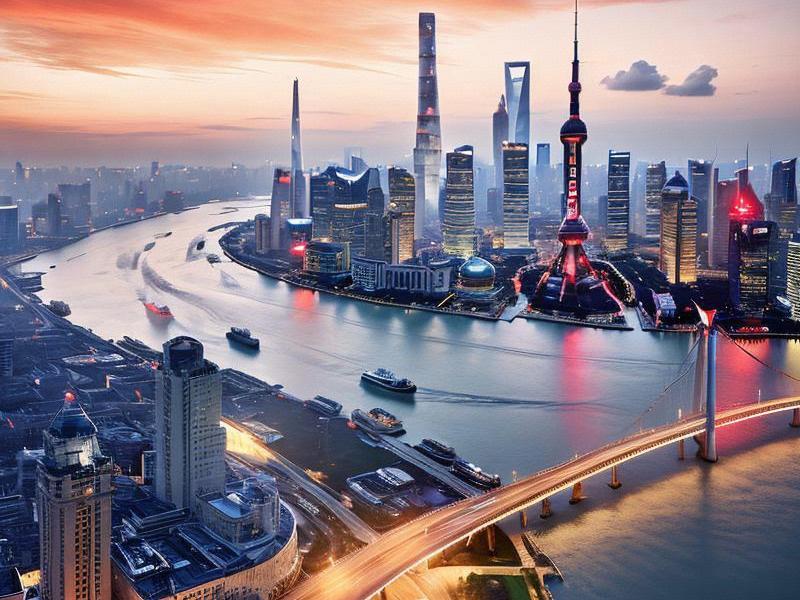This article delves into the remarkable transformation of Shanghai, exploring its evolution from a historical port city to a global metropolis that is a beacon of urban innovation and cultural renaissance.

Shanghai, a city that has long been a symbol of China's economic and cultural vitality, is undergoing a profound transformation. Once a humble fishing village, it has risen to become one of the world's most dynamic cities, renowned for its skyline, bustling markets, and rich cultural heritage. This article aims to explore the multifaceted changes that have shaped Shanghai into the global city it is today, focusing on its urban development, technological advancements, and cultural resurgence.
The story of Shanghai's transformation is deeply intertwined with the broader narrative of China's economic reform and opening up. In the late 20th century, Shanghai began to embrace market-oriented reforms, which unleashed a wave of economic activity and investment. The city's strategic location along the Yangtze River and its proximity to the East China Sea made it a natural hub for trade and commerce. Over the years, Shanghai has leveraged these advantages to establish itself as a leading financial center in Asia, attracting multinational corporations, foreign investors, and talented professionals from around the globe.
One of the most striking aspects of Shanghai's urban transformation is its skyline, which has been reshaped by a series of iconic skyscrapers. The Oriental Pearl Tower, the Jin Mao Tower, and the Shanghai World Financial Center are just a few examples of the architectural marvels that have turned Shanghai into a modern metropolis. These structures not only symbolize the city's economic prowess but also serve as a testament to its commitment to innovation and excellence. The Bund, once a colonial-era waterfront promenade, has been revitalized with the construction of the Pudong New Area, home to some of the tallest buildings in the world.
In addition to its physical transformation, Shanghai has also embraced technological advancements that have further cemented its status as a global leader. The city has invested heavily in smart city initiatives, leveraging cutting-edge technologies such as artificial intelligence, big data, and the Internet of Things (IoT) to enhance the quality of life for its residents. Smart traffic management systems, efficient public transportation networks, and digital payment solutions are just a few examples of how Shanghai is harnessing technology to crteeaa more connected and sustainable urban environment.
阿拉爱上海
The rapid pace of urbanization in Shanghai has brought about significant challenges, including the need to balance economic growth with environmental sustainability. The city has taken proactive measures to address these issues, implementing policies aimed at reducing pollution, promoting green energy, and preserving its natural resources. The construction of the Shanghai Greenway Network, a sprawling network of parks, riverside walkways, and bike paths, is a prime example of the city's commitment to creating a more livable and eco-friendly urban space.
Culturally, Shanghai has experienced a renaissance that reflects its unique blend of tradition and modernity. The city is home to a vibrant arts scene, with numerous galleries, theaters, and music venues showcasing the works of both local and international artists. The Shanghai Museum, one of the largest and most prestigious museums in China, houses an impressive collection of ancient Chinese art, while the city's contemporary art scene is thriving, thanks to initiatives such as the Shanghai Biennale and the Power Station of Art.
The culinary landscape of Shanghai is another aspect of its cultural renaissance. The city is renowned for its distinctive cuisine, which combines the flavors of Jiangsu and Zhejiang provinces with influences from other regions of China and beyond. From the famous xiaolongbao (soup dumplings) to the delicate xiaolongbao (soup dumplings), Shanghai's culinary offerings are a testament to its rich gastronomic heritage. The city's night markets and food streets are a feast for the senses, offering a wide array of dishes that cater to diverse tastes and preferences.
新夜上海论坛
Education and research are also playing a crucial role in Shanghai's transformation. The city is home to several world-class universities and research institutions, including Fudan University, Tongji University, and the Shanghai Jiao Tong University. These institutions are at the forefront of scientific research and innovation, contributing to the development of new technologies and solutions that address global challenges. Shanghai's emphasis on education and research has helped to attract top talent from around the world, further fueling its economic and cultural growth.
Tourism is another area where Shanghai has seen significant growth, driven by its unique blend of history, culture, and modernity. The city's historic districts, such as the French Concession and the Old City, offer a glimpse into its colonial past, while its modern attractions, such as the Shanghai Tower and the Shanghai Disneyland Resort, showcase its contemporary appeal. The city's well-preserved architecture, vibrant festivals, and rich cultural heritage make it a popular destination for tourists from all over the world.
Despite its many achievements, Shanghai continues to face challenges as it seeks to maintain its position as a global leader. Issues such as income inequality, housing affordability, and environmental sustainability require ongoing attention and innovative solutions. The city's government has implemented a range of policies aimed at addressing these challenges, including affordable housing programs, social welfare initiatives, and environmental protection measures.
上海龙凤419体验
Looking ahead, Shanghai's future is bright, with opportunities for further growth and development. The city is poised to play a key role in China's Belt and Road Initiative, which aims to strengthen connectivity and cooperation between Asia, Europe, and Africa. Shanghai's strategic location and expertise in finance, logistics, and technology make it a vital node in this global initiative.
In conclusion, Shanghai's transformation is a story of resilience, innovation, and cultural renaissance. From its humble beginnings as a fishing village to its current status as a global metropolis, the city has undergone a remarkable journey of urban development and cultural evolution. As Shanghai continues to grow and adapt to the changing world, it remains a beacon of hope and inspiration for cities around the globe.